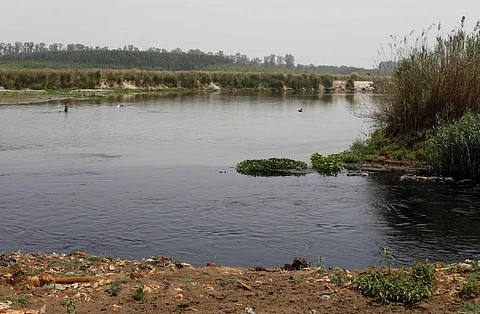

The Indian Council for Medical Research has informed the government about a 2024 study that found people living near river drains in Punjab were highly prone to cancer.
In a written reply to a question on cancer cases, Union Minister of State for Health and Family Welfare Prataprao Jadhav informed the Rajya Sabha of the study by researchers from Punjabi University and Thapar University in Patiala had found that the levels of heavy metals like lead, iron and aluminium exceeded the permissible limit of the Central Pollution Control Board.
The researchers analysed wastewater drains of the Ghaggar river in Punjab, highlighting enormous amounts of heavy metal contamination in the study area.
“The heavy metal pollution of surface water is also considered responsible for degradation of groundwater quality, which is further posing a severe threat to the potable water,” the researchers wrote in the study, adding that the major source of heavy metals was untreated discharge from wastewater drains into the rivers.
The researchers flagged limited data availability on heavy metal distribution in wastewater drains in Punjab. They also noted that there was no report on water quality indices and human health risk assessments. The findings were published in the journal Indian Academy of Sciences.
To address these gaps, the team collected samples from three drains of the Ghaggar — Sirhind Choe, Badi Nadi, and Dhakanshu Drain — between October 2017 and July 2018 in different seasons, including post-monsoon, winter, post-winter transitional, summer, and monsoon.
They determined the concentrations of metals, including lead, cadmium, iron, aluminium, and nickel. The World Health Organization has classified cadmium, nickel, and lead as carcinogenic to humans.
People can be exposed to heavy metals through two routes: direct exposure by drinking surface water and indirect exposure through skin contact with surface water during domestic activities such as bathing and washing.
The concentration of iron and aluminium during the monsoon season was several times higher than the permitted CPCB levels, the paper found. This drastic increase, they explained, indicated the discharge of agricultural runoff and untreated wastewater into drains.
The hazard index (HI) values, which measure non-carcinogenic risk for the two exposure routes, were found to be significantly greater than 1 for lead at all sites. An HI level exceeding 1 indicates a high possibility of non-carcinogenic health issues.
The researchers stressed the urgent need to manage and remove these toxic contaminants, especially lead and cadmium. They added that non-carcinogenic risk was higher in children than in adults.
They also calculated carcinogenic risk values for lead, cadmium, and nickel, which exceeded the safe limits set by US regulators. This suggested that people living near the drains had a high risk of developing cancer due to metal exposure from surface water. The results further indicated that the prevalence of cancer was higher in children than in adults.
Similar health issues have been found in western Uttar Pradesh due to the Hindon river, but the state government denies any links to cancer.
Previously, Down To Earth travelled to southwestern Punjab and found that people in several villages reported a high burden of diseases. Cancer cases, mystery illnesses, and dental problems were common. Industrial effluents and municipal wastewater pollution were identified as key contributors to contaminated water sources and air pollution.